Pharmaceutical Technology's 2005 Manufacturing Rankings
Pharmaceutical Technology provides perspective on pharmaceutical manufacturing activity, assessing the product portfolios, prescription volumes, revenues, and capital spending plans of more than 500 drug-makers. Novartis leads in diversity, with 889 products; Pfizer leads in number of scrips (352 million) and revenue ($44 billion). And generics companies are coming up on the inside.
For its first snapshot of US pharmaceutical manufacturing activity, Pharmaceutical Technology reviewed five sources of information: our sister publication Pharmaceutical Executive's annual ranking of sales revenue and research and development (R&D) investment (see Table I); prescription (Rx) volumes (see Table II) tabulated by IMS Health (Fairfield, CT, www.imshealth.com); the US Food and Drug Administration's database of approved drugs (see Tables III–V); company statements on manufacturing facility investments and rationalizations; and long-term capital investment plans tracked by Industrial Info Resources (Sugar Land, TX, www.industrialinfo.com).
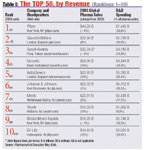
Table I: The TOP 50, by Revenue
Product portfolios
Drugs@FDA is FDA's database of prescription and over-the-counter (OTC) human drugs currently approved for sale in the United States (1). The database does not include vaccines or OTC drugs that were not approved through a new drug application (NDA).
Of the 21,502 products listed in Drugs@FDA (accessed on May 30, 2006), 12,708 are currently active. Of these, 93% (11,807) are approved for prescription use, 400 are listed for OTC sale, and the remaining 501 have "tentative approval."
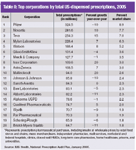
Table II: Top corporations by total US-dispensed prescriptions, 2005
The database lists 876 manufacturers for currently approved drugs—from 3M (St. Paul, MN) and AAIPharma (Wilmington, NC) through ZLB Behring (King of Prussia, PA) and Zydus Pharmaceuticals (USA) (Princeton, NJ). (This raw total is misleading, however; see related sidebar).
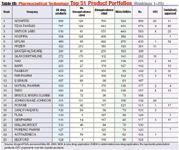
Table III: Pharmaceutical Technology Top 51 Product Portfolios
So, who is number one?
Novartis (Basel, Switzerland) leads the Pharmaceutical Technology Top 51, (see Table III) with a portfolio of 889 drug products currently approved by FDA, based on 529 separate approved applications (NDAs and abbreviated new drug applications). Teva Pharmaceutical Industries (Petach Tikva, Israel) follows in second position, with 767 approved products in its portfolio. Next come Watson Pharmaceuticals (Corona, CA) with 616, Hospira (Lake Forest, IL) with 564, and Mylan Laboratories (Canonsburg, PA) with 488. Pfizer (New York, NY), the revenue leader, takes sixth position, with 392 approved products.
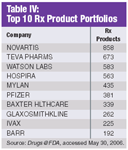
Table IV: Top 10 Rx Product Portfolios
The product-portfolio list tilts heavily towards generics companies, as does the industry. In 2004, for the first time, consumers filled more prescriptions with generics than with branded pharmaceuticals. Since then, the consumption numbers, and consequently the manufacturing numbers, have continued to swing toward the generics side of the house.

Table V: Top 10 OTC Product Portfolios
Therapeutic equivalents dominate
Drugs@FDA posts a therapeutic equivalence (TE) code for 69% of the products listed, indicating that the product either is generic or has generic competitors, or that the company has developed line-extensions of branded products (exclusivity data are included in a separate database and were not analyzed for this ranking). Generics companies, as expected, show broad dependence on therapeutically equivalent products, with TE codes for 80% or more of their portfolios. Research-based companies tend to list TE codes for less than 60% of their portfolios. Just 47% of Pfizer's portfolio, for example, lists therapeutic equivalence ratings. (There are exceptions, however, at both ends of the TE code spectrum.)

Rx: Take data with a grain of salt
Two hundred dosage forms
It comes as no surprise that the most common route of administration is oral, accounting for 64% of Rx and 58% of OTC products. Among oral prescription formulations, 85% fall into familiar classes: "tablet; oral," "capsule; oral," "tablet, extended release; oral," "capsule, extended release; oral," "solution; oral," "for suspension; oral," and "syrup; oral." There are, however, another 49 listed oral dosage forms, 17 of them represented by just a single product. The single-product delivery classifications include "film, extended release; buccal" (lidocaine from Noven) and "capsule, tablet, capsule, delayed rel pellets; oral" (for TAP's "Prev-pac," a combination of amoxicillin, clarithromycin, and lansoprazole). Overall, FDA recognizes 200 dosage forms (see Figure 1).
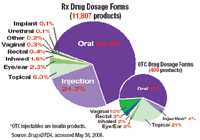
Figure 1: Prescription (Rx) and Over-the-Counter (OTC) Dosage Forms
Revenue rankings
The revenue ranking, compiled by Pharmaceutical Executive for its May 2006 (2) issue, puts Pfizer solidly at the top with 2005 global pharmaceutical sales of $44.3 billion, then GlaxoSmithKline (GSK, London) at $34.0 billion, Sanofi-Aventis (Paris) at $32.3 billion, Novartis at $25.0 billion, and AstraZeneca (London) at $24.0 billion.
The ratio of R&D spending to total sales shows three regimes. The first category consists of companies spending 20% or more of sales revenues on R&D, falling into what has traditionally been biotechnology territory. Qualifiers in this category from the Pharm Exec 50 include Johnson & Johnson (New Brunswick, NJ), Schering-Plough (Kenilworth, NJ), AstraZeneca, Roche (Basel, Switzerland), and Eli Lilly (Indianapolis, IN), along with Biogen Idec (Cambridge, MA), MedImmune (Gaithersburg, MD) Genentech (South San Francisco, CA), and Genzyme (Cambridge, MA).
The middle group, spending 10–20% of revenues on R&D, holds to the traditional ratios of Big Pharma. And generics companies and Wyeth (Madison, NJ) cluster in the third group, spending 7–10% of revenues on R&D.
Prescription volume rankings
Given the price gap between branded and generic products, the Pharmaceutical Technology Top 51 tend to track IMS Health prescription volume figures (see Table II) rather than revenue. Pfizer tops this list, too, with 325 million prescriptions, followed by Novartis (at 282 million prescriptions), and three generics houses: Teva, Mylan, and Watson.
Five drugs accounted for roughly 60% of Pfizer's total prescriptions: "Lipitor" (atorvastatin) at 79.2 million prescriptions, "Norvasc" (amlodipine) at 40.3 million, "Zoloft" (sertraline) at 31.7 million, "Zithromax Z-Pak (azithromycin) at 23.1 million, and "Zyrtec" (cetirizine) at 22.0 million, according to IMS data.
Also making the top 10 by volume were GSK, Merck & Co., and Astra-Zeneca. GSK did not have a product in the top 20 products by total US dispensed prescriptions in 2005. Merck had three: "Zocor," (simvastatin), "Singulair," (montelukast), and "Fosamax" (alendronate). AstraZeneca had two drugs in the top 20: "Toprol-XL" (metoprolol) and "Nexium" (esomeprazole).
Revenue Top 20 target biologics and restructure manufacturing
Restructuring manufacturing, increasing investment in biologics and vaccine production, and select investment in secondary manufacturing characterize the pharmaceutical majors' investment activity during the past year and a half.
Pfizer proceeds with restructuring. Under its "Adapting to Scale" (AtS) program, a multiyear productivity initiative launched in 2005, Pfizer hopes to achieve annual cost savings of $4 billion by 2008, part of which will come from optimizing its manufacturing network.

2006 North American Pharmaceutical Industry Project Spending Analysis
During 2005 and the first quarter of 2006, Pfizer identified 15 manufacturing sites for rationalization: Angers and Val de Reuil, France; Arecibo and Cruce Dávila, Puerto Rico; Augusta, Georgia; Corby and Morpeth, UK; Holland, Michigan; Jakarta, Indonesia; Seoul, South Korea; Orangeville, Canada; Parsippany, New Jersey; Tsukuba, Japan; and Stockholm and Uppsala-Fyrislund, Sweden.
In addition, Pfizer says there have been extensive reductions in site operations in the Sandwich, UK (the planned closure of drug product, distribution, and fermentation operations); Lincoln and Omaha, Nebraska; and Puerto Rico sites (staff reductions), with smaller staff reductions in Groton, Connecticut and Lititz, Pennsylvania.
Thus far in 2006, Pfizer has agreed to sell its facilities in Cruce Dávila, Puerto Rico to Abraxis Biosciences, Inc. (Los Angeles, CA), its pharmaceutical manufacturing facilities in Augusta, Georgia to Xethanol Corporation (New York, NY), its active pharmaceutical ingredient (API) and finished-drug manufacturing plant at Uppsala, Sweden to Kemwell Pvt. Ltd. (Bangalore, India), and its facility in Morpeth, UK to NPIL Pharma (Mumbai, India).
GSK and Sanofi-Aventis invest in vaccine production. GSK is investing roughly £102 million ($188 million) over the next four years in a new vaccine manufacturing plant in Singapore for the primary production of pediatric vaccines. In 2005, it strengthened its global vaccine production network in North America through three major acquisitions: Corixa Corporation; a vaccine production site in Marietta, Pennsylvania, acquired from Wyeth; and ID Biomedical with flu vaccine manufacturing facilities in Canada. GSK is expanding and upgrading ID's manufacturing facilities to allow for the production of 75 million doses per year of ID's "Fluviral" egg-based influenza vaccine.
GSK also is investing £64 million ($118 million) to expand vaccine production in Dresden, Germany. The project is scheduled for completion in 2008.
Sanofi-Aventis's principal capital expenditures for 2006 include a new vaccine production facility in the United States and a vaccine formulation–filling facility in France.
Sanofi Pasteur, the vaccines business of Sanofi-Aventis, is investing $30 million in its Toronto, Canada component pertussis and polio vaccine facilities. In 2005, Sanofi Pasteur completed a multi-year, capital expansion at its vaccine production facilities in Swiftwater, Pennsylvania. The site includes an influenza vaccine manufacturing facility. Also in 2005, Sanofi began construction of a 145,000-ft2 , $150-million manufacturing facility in Swiftwater, which will replace its existing plant and double the site's capacity there for the 2008–2009 influenza season. Sanofi also is investing EUR 160 million ($202 million) for a formulation–filling facility in Val de Reuil, France and will expand cell-culture-based virology production at its facility in Marcy l'Etoile, France.
Novartis invests in China and Singapore. In its first such project in China, Novartis is investing $83 million to build a manufacturing facility for synthesizing small amounts of developmental APIs to support early-phase development activities. It also is constructing a $195-million tableting facility in Singapore.
Novartis further strengthened its manufacturing network through its acquisition of Chiron Corporation, gaining manufacturing facilities in Liverpool, UK; Marburg, Germany; Siena, Italy; Rosia, Italy; Ankleshwar, India; and Emeryville and Vacaville, California. Acquisitions of generics companies Hexal AG and Eon Labs expanded its network with plants in Europe, North America, and Asia.
AstraZeneca restructures. AstraZeneca realigned its manufacturing network in 2005. It sold its bulk drug facility in Guayama, Puerto Rico and formulation and packaging facilities in Naucaplan, Mexico and Manila, Philippines. Its expenditures on supply and manufacturing facilities totaled $206 million in 2005, compared with $352 million in 2004.
Johnson & Johnson invests in biologics capacity. Johnson & Johnson subsidiary Centocor is building a 28,000-m2 biologics manufacturing facility in Ringaskiddy, Cork, Ireland, which is scheduled to come on-line by 2010.
Merck moves with new supply strategy. As part of its new supply strategy, Merck & Co Inc. plans to sell or close 5 of its 31 manufacturing sites and 2 preclinical sites by the end of 2008 and eliminate approximately 7000 positions company wide. The manufacturing sites slated to close are Ponders End, UK; Okazaki, Japan; Kirkland, Canada; Albany, Georgia; and Danville, Pennsylvania. The two preclinical sites are in Okazaki and Menuma, Japan. Merck also plans to close its basic research center in Terlings Park, UK.
Amidst restructuring, Merck is building a new, $300-million vaccine manufacturing facility in Durham, North Carolina. The facility will manufacture some of Merck's existing products such as measles, mumps, rubella, and chicken pox vaccines. Long term, it will support the manufacturing of new vaccines. Merck's 2005 capital expenditures for production facilities were $510.7 million.
Wyeth targets biologics with $2-billion project. Wyeth's key project in 2005 was the opening of a $2-billion biotech production facility in Grange Castle, Ireland. Among the biotech products to be produced there are "Enbrel"(etanercept), "Prevnar" (pneumococcal 7-valent conjugate vaccine [diphtheria CRM197 protein]), and "Tygacil" (tigecycline).
In 2005, Wyeth also increased manufacturing capacity at facilities in Andover, Massachusetts; Sanford, North Carolina; New Bridge, Ireland; and Guayama, Puerto Rico. It also sold its Marietta, Pennsylvania vaccine facility to GSK.
In 2005, Wyeth launched Project Springboard, a multiyear initiative designed to improve R&D productivity and increase operational efficiencies, including manufacturing. Wyeth estimates the cost of the project at between $750 million and $1 billion.
BMS ups biologics capacity. Bristol-Myers Squibb (BMS, New York, NY) is investing $660 million in a new, large-scale, multiproduct bulk-biologics facility in Devens, Massachusetts to support increased production of "Orencia" (abatacept) and other biologic compounds in development. It is investing $200 million to expand its finish and package biologics facility in Manati, Puerto Rico.
Board approval for the $660-million capital project comes as BMS continues its goal of reducing costs by $500 million by 2007 and by an additional $100 million by 2008 company-wide, which includes technical operations. These savings are addition to annual reductions of $200 million achieved in 2004 and 2005.
Eli Lilly invests in secondary manufacturing. In 2005, Eli Lilly subsidiary Lilly del Caribe Inc. opened a new, $200-million laboratory and a specialized capsule manufacturing unit in Carolina, Puerto Rico. The investment is an expansion of Lilly's PR–1 plant, where the fill–finishing manufacturing process for the antidepressant "Cymbalta" (duloxetine) is performed. Eli Lilly also stopped producing the bulk active ingredient for "Xigris" (drotrecogin alfa [activated]) at its Indianapolis site and discontinued manufacturing human pharmaceutical products at its Clinton, Indiana facility, which now makes products solely for Lilly's Elanco Animal Health business.
Lilly is building an insulin manufacturing facility in Prince William County, Virginia to formulate, fill, and package various forms of "Humalog" and "Humulin" recombinant insulin products.
Abbott proceeds with restructuring. In 2005, Abbott Laboratories (Abbott Park, IL) approved plans to realign its global manufacturing operations and booked pretax charges against earnings of roughly $256 million, reflecting the impairment of manufacturing facilities and other assets, employee severance, and other charges. Manufacturing-related realignments are expected to continue into 2007, according to the company's 2005 annual report.
Roche ups antiviral, biotech activity. Roche is expanding its capacity for the antiviral drug "Tamiflu" (oseltamivir) by 100 million treatments, which will give it annual capacity to produce as much as 400 million treatments by the end of 2006. The ramp-up of capacity is being achieved through the addition of 15 external manufacturers and the expansion of Roche-owned facilities.
In 2005, the company dedicated new production facilities in Penzberg, Germany for epoetin and CERA (continuous erythropoiesis receptor activator) and in Mannheim, Germany for a packaging and storage facility for injectable drugs. The two facilities have been operational since the middle of 2005. New production facilities for biotechnological APIs in Basel, Switzerland and Penzberg, Germany are scheduled for technical completion in 2007. Roche also dedicated a plant for high-potency pharmaceuticals in Shanghai.
On the small-molecule side, Roche sold its chemical-production plant in Cuernavaca, Mexico to Dr. Reddy's Laboratories (Hyderabad, India) in 2005.
Amgen expands. Amgen (Thousand Oaks, CA) is investing $1 billion over the next four years to expand its biologics manufacturing capacity in Puerto Rico. This includes expanding its bulk production plant for "Neupogen" (filgrastim) and "Neulasta" (pegfilgrastim), an expansion of the built (but not yet licensed) bulk-protein plant for "Epogen" (epoetin alfa) and "Aranesp" (darbepoetin alfa), a new fill–finish facility, and enhancements to its existing fill–finish facility. It also is investing $1 billion in new process development, bulk-protein manufacturing, formulation, and fill–finish facilities in Cork, Ireland, scheduled to be operational in 2009.
These investments are in addition to Amgen's $2.2-billion acquisition of Abgenix, Inc. (Fremont, CA) in 2006. The deal included Abgenix's 100,000-ft2 manufacturing plant in Fremont, California that will produce panitumumab. In 2005, Amgen also opened a new manufacturing facility in West Greenwich, Rhode Island to produce Enbrel.
Boehringer-Inghelheim boosts capacity. Boehringer-Inghelheim (Ingelheim, Germany), which also provides contract manufacturing services, is investing EUR 70 million ($88 million) to modernize and expand high-yield fermentation processes for mammalian cell cultures at its biopharmaceutical production facility in Biberach, Germany, scheduled for completion in 2007.
Boehringer Ingelheim further invested EUR 80 million ($101 million) to add a new biopharmaceutical production plant in Vienna, Austria. The plant opened in April 2005, doubling its microbial production capacity to bring its total fermentation capacity to 12,000 L (two 6000-L fermenters).
Takeda increases API capacity. Takeda Pharmaceutical Company Limited (Osaka, Japan) has entered trial production for its 12 billion-yen ($105 million) API plant in Clondalkin, Dublin, Ireland. In March 2006, the company closed its plant in Shonan, Japan, which had manufactured OTC products. The manufacture of those products was transferred to one of Takeda's subsidiaries in Japan.
Astellas debuts. Astellas Pharma, Inc. (Tokyo, Japan) was created in April 2005 through the merger of two Japanese pharmaceutical companies: Yamanouchi Pharmaceutical Co., Ltd. and Fujisawa Pharmaceutical Co., Ltd. Its two main production facilities are in Toyama and Yaizu, Japan. The company also maintains other manufacturing sites in Japan. Astellas closed its plant in Kuanyin, Japan in June 2005 and the Osaka plant of Astellas Toyama, its manufacturing subsidiary, in March 2006. It also has manufacturing sites in Ireland, Germany, the Netherlands, Italy, and China.
Schering-Plough restructures. Schering-Plough plans to discontinue manufacturing operations in Manati, Puerto Rico by the end of 2006 and reduce its workforce at manufacturing facilities in Las Piedras, Puerto Rico and Union and Kenilworth, New Jersey. Overall, it plans to reduce its workforce by roughly 1100 positions.
Bayer, Schering AG combine. Bayer AG's (Leverkusen, Germany) proposed acquisition of Schering AG (Berlin, Germany) would enhance Bayer's manufacturing capabilities in North America, Europe, and Asia. At press time, Bayer had increased its offer for Schering AG to EUR 89 per share for a total purchase price of EUR 16.9 billion ($21.3 billion). Merck KGaA (Darmstadt, Germany), which made a hostile takeover bid for Schering AG had earlier this year, agreed to sell Bayer its 21.8% stake in Schering to facilitate the deal and the pending formation of a combined Bayer and Schering AG.
Genentech ramps up. Genentech is adding 200,000 L of bioreactor capacity with a new manufacturing facility at its site in Vacaville, California, which is expected to be licensed in 2009. It also added 90,000 L of bioreactor capacity in 2005 through its $408-million purchase of Biogen Idec's Oceanside, Califorina facility, which is planned to manufacture "Avastin" (bevacizumab). Genentech is also adding 20,000 L of bioreactor capacity in Porriño, Spain for Avastin production, with licensure expected in 2006.
References
1. Center for Drug Evaluation and Research, US Food and Drug Administration, "Drugs@FDA Data Files," http://www.fda.gov/cder/drugsatfda/datafiles/default.htm, accessed May 30, 2006.
2. N. Gray, "Changing Landscapes: A Special Report on the World's Top 50 Pharma Companies," Pharmaceutical Executive 26 (5), 77–88 (May 2006).

Drug Solutions Podcast: A Closer Look at mRNA in Oncology and Vaccines
April 30th 2024In this episode fo the Drug Solutions Podcast, etherna’s vice-president of Technology and Innovation, Stefaan De Koker, discusses the merits and challenges of using mRNA as the foundation for therapeutics in oncology as well as for vaccines.
Pharmaceutical Tariffs Are Imminent: How Industry is Bracing for Impact
April 16th 2025On April 14, 2025, the Trump Administration launched a national security-driven investigation into pharmaceuticals, a move that will likely result in tariffs being placed on pharmaceutical drugs, ingredients, and other components that are imported from outside of the United States.